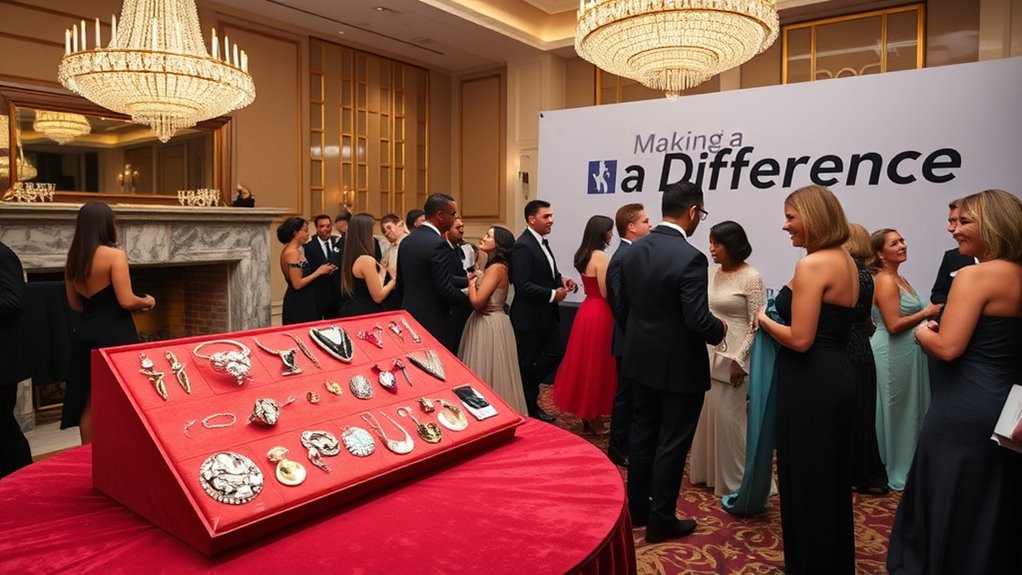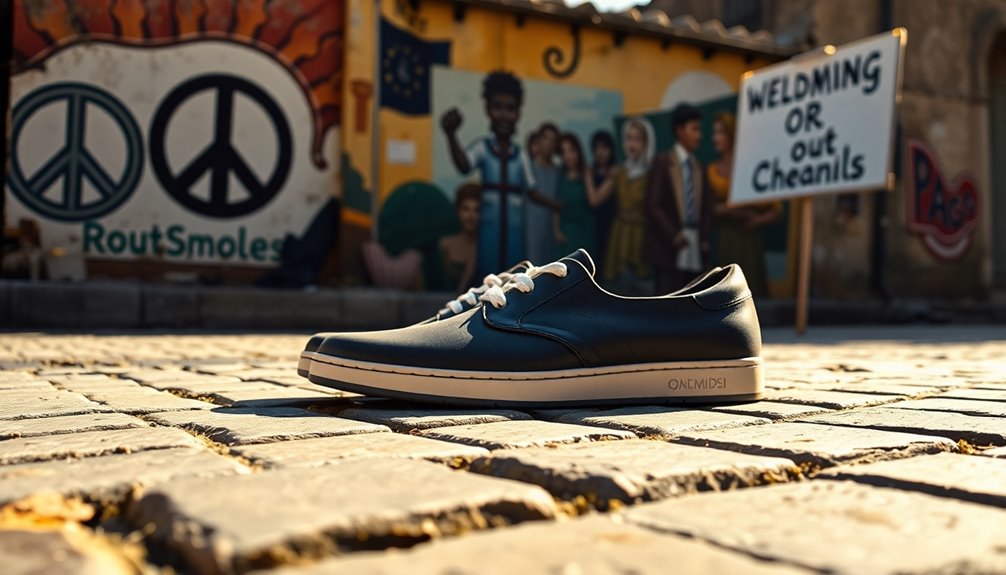In the luxury sector, philanthropy now goes beyond traditional donations, focusing on impactful initiatives that promote sustainability, cultural preservation, and social change. By partnering authentically and ensuring transparency, brands build trust and meet rising consumer expectations for responsible practices. They utilize innovative tools like AI analytics to maximize their social impact. If you want to discover how these strategies are shaping the future of luxury social responsibility, there’s more to explore.
Key Takeaways
- Luxury brands integrate social impact, sustainability, and cultural preservation into their core values through targeted initiatives and strategic collaborations.
- Authentic partnerships, transparent communication, and impact reporting build trust and demonstrate genuine commitment to social responsibility.
- Consumer demand for ethical practices influences luxury brands to adopt responsible sourcing, eco-friendly materials, and transparent supply chains.
- Advanced data analytics and AI tools help luxury companies measure, forecast, and optimize the social impact of their philanthropic efforts.
- The industry’s future emphasizes biodiversity protection, ethical sourcing, and long-term societal benefits aligned with evolving consumer expectations.
The Evolution and Scope of Luxury Philanthropy
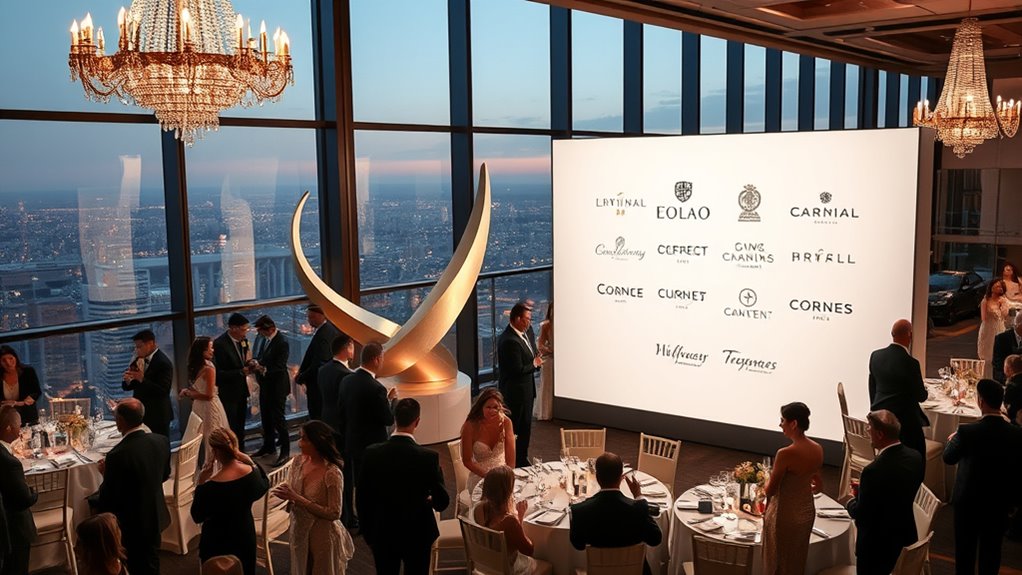
The scope of luxury philanthropy has considerably expanded over the past two decades, reflecting a shift in how brands engage with social responsibility. Today, luxury brands like Cartier and Louis Vuitton have established foundations that focus on social impact, cultural promotion, and sustainability. These initiatives often incorporate heritage preservation as a core element, emphasizing the importance of maintaining cultural identity through charitable efforts. These brand initiatives go beyond traditional charity, encompassing education, conservation, and social justice. As a result, luxury philanthropy now plays a crucial role in demonstrating corporate responsibility and enhancing brand reputation. Industry leaders actively partner with global organizations such as the UN and Médecins Sans Frontières, training thousands of individuals and supporting diverse causes. This evolution is driven by changing consumer expectations, regulatory pressures, and a strategic focus on embedding social impact into the core identity of luxury brands. Incorporating survival skills and community engagement strategies, many luxury brands are also exploring ways to contribute to resilience and preparedness in vulnerable communities. Additionally, the integration of home furnishings and comfort solutions, such as heated mattress pads, into philanthropic efforts reflects an understanding of basic needs and well-being. Moreover, this expansion in scope demonstrates a broader recognition of the importance of social impact in shaping consumer loyalty and brand legacy.
Key Strategies and Focus Areas for Impactful Giving
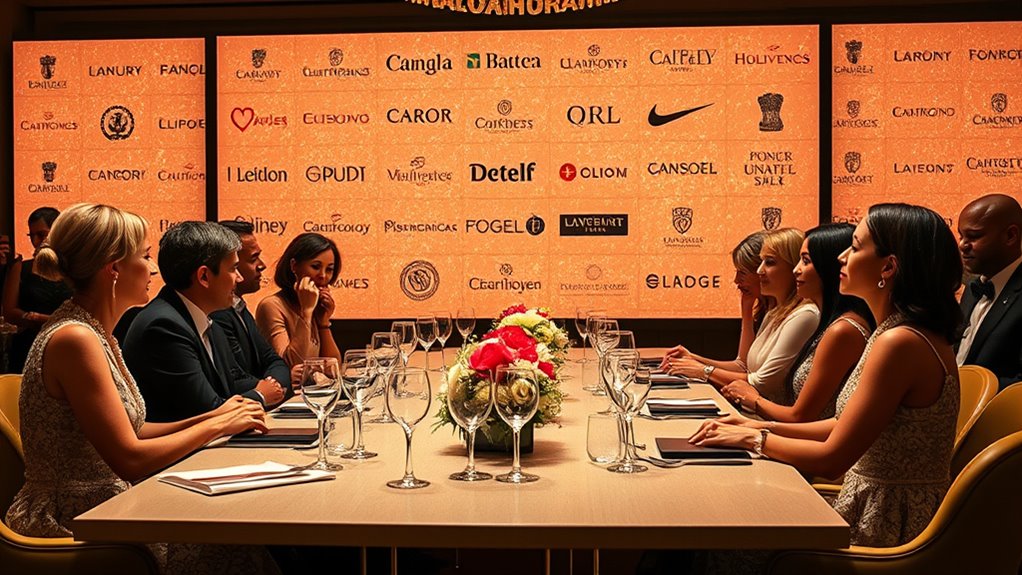
Luxury brands adopt targeted initiatives and strategic partnerships to maximize their social impact. They focus on social causes like education, conservation, gender equality, and community empowerment, aligning philanthropy with their core values. For example, Gucci’s €5 million fund supports diversity, while Louis Vuitton’s foundation promotes emerging artists. Strategic collaborations, such as Bulgari’s work with Save the Children, amplify impact and boost brand reputation. Many brands dedicate a portion of sales or profits to philanthropy, maintaining transparency through detailed impact reports and independent audits. Innovative models like profit-sharing, exemplified by Ninety Percent, are redefining traditional giving for long-term societal benefits. Additionally, some brands leverage green initiatives to enhance sustainability and social responsibility. Developing a creative practice approach to philanthropy can foster innovative solutions that resonate with consumers and communities alike. Incorporating philanthropic impact measurement is essential for demonstrating effectiveness and accountability, ensuring that efforts lead to tangible change. The integration of community engagement strategies further helps brands connect authentically with local populations and address specific needs. These strategies enable luxury brands to create meaningful change, demonstrating that impactful giving is both purposeful and sustainable.
Building Authentic Partnerships and Ensuring Transparency
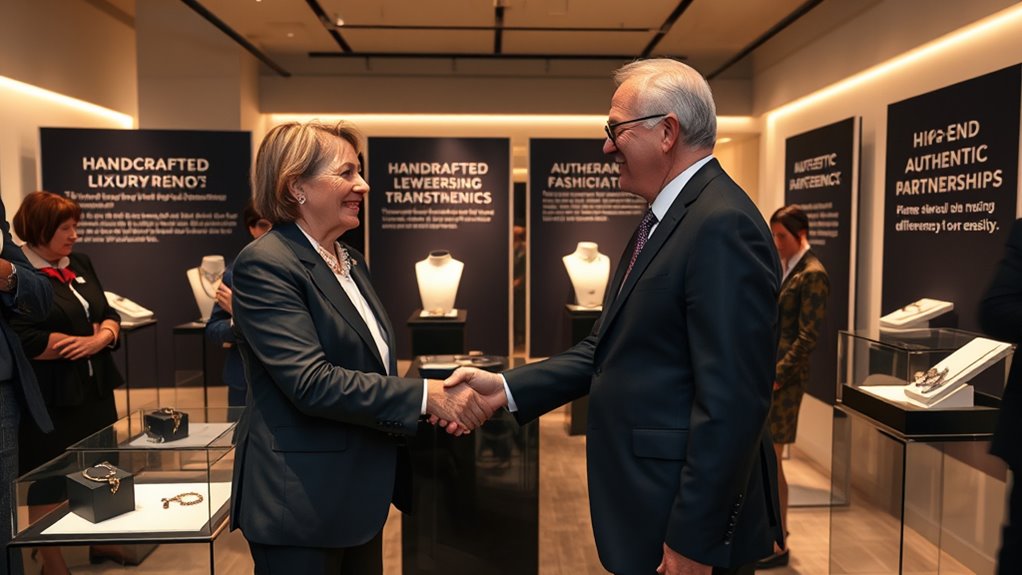
Building authentic partnerships in luxury philanthropy requires careful alignment of brand values with the missions of non-profit organizations. You should thoroughly vet foundations’ backgrounds, ensuring transparency and a clear focus on social impact. Luxury brands like Cartier and Bulgari exemplify authenticity by integrating charitable efforts seamlessly into their brand identity, such as supporting women’s empowerment or collaborating with Save the Children. Open communication about partnership goals, progress updates, and beneficiary stories builds trust and demonstrates genuine commitment. Maintaining transparency through regular impact reports, independent audits, and digital tools enhances accountability, allowing stakeholders to verify the effective use of funds. Recognizing the importance of anime culture, many brands incorporate storytelling elements from popular animated movies or series to connect emotionally with audiences. Additionally, employing comprehensive monitoring and evaluation practices ensures that partnerships remain aligned with their social objectives and adapt to changing needs. Incorporating digital transparency tools can further boost stakeholder confidence by providing real-time insights into project outcomes. For example, leveraging herbal tea brewing techniques to showcase meticulous care and authenticity can mirror the transparency a brand aims to project. When done right, these authentic partnerships not only strengthen your brand’s credibility but also maximize social impact and foster long-term trust.
Leveraging Consumer Expectations and Driving Industry Trends
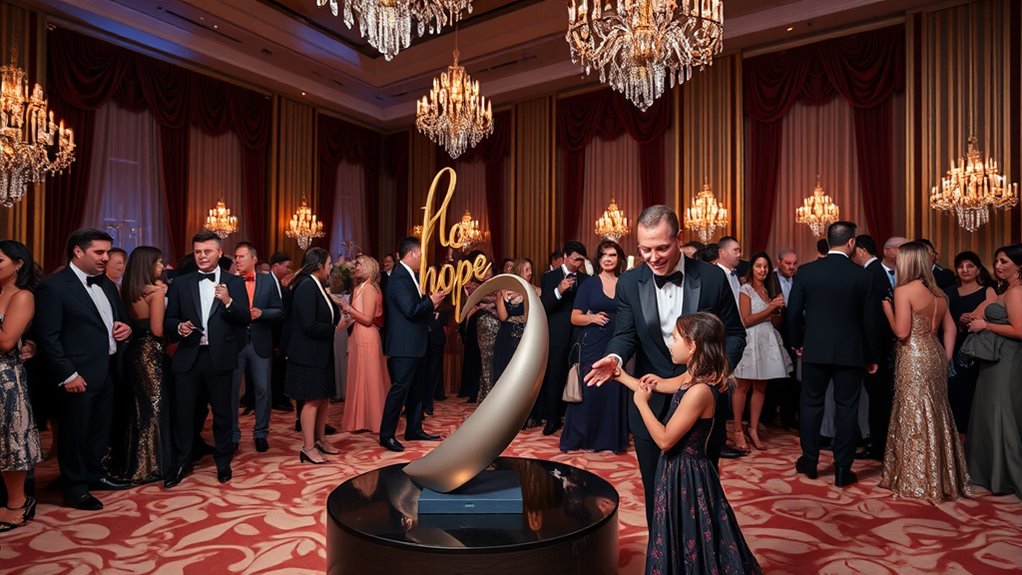
As consumer expectations shift toward greater social and environmental responsibility, brands must proactively align their practices with these evolving values. In the luxury fashion industry, sustainability and social impact now drive purchasing decisions, especially among Gen Z, with 72% considering ethical practices. Consumers increasingly base their choices on brand values, making authentic philanthropy and ethical practices crucial for relevance. Young consumers actively seek brands committed to societal and ecological causes, pushing luxury brands to adapt their strategies accordingly. The COVID-19 pandemic has further accelerated philanthropic efforts, emphasizing social impact. Industry reports show that media coverage and public perception favor brands demonstrating genuine, impactful philanthropy aligned with consumer expectations, ultimately shaping industry trends and reinforcing the importance of responsible business practices. Incorporating personal development tools such as goal setting and self-reflection can further enhance corporate social responsibility initiatives, creating more meaningful connections with socially conscious audiences. Additionally, fostering Cultural Intelligence within organizations can help brands better understand and respond to diverse consumer values globally.
Charting the Future of Social Responsibility in Luxury
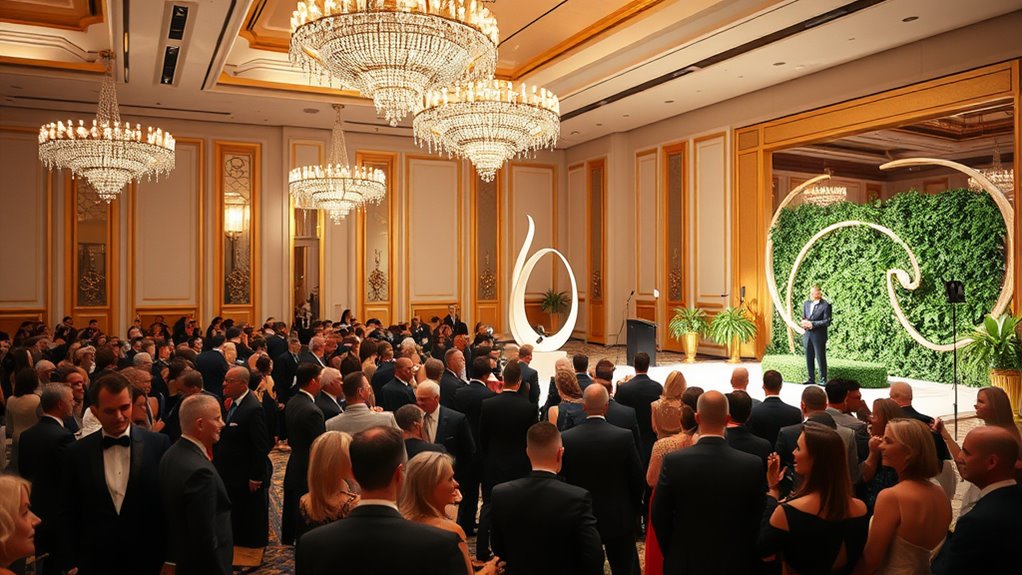
The future of social responsibility in the luxury sector is being shaped by innovative strategies that prioritize genuine impact and transparency. You’ll see brands embedding social and positive philanthropy into their core identity, focusing on education, conservation, and social justice. Strategic partnerships, like Bulgari’s support for Save the Children or Cartier’s cultural programs, amplify their community efforts and demonstrate ethical leadership. Consumers increasingly demand transparency, with 65% of luxury buyers valuing sustainability, rising to 72% among Gen Z. Future initiatives will challenge traditional profit models, embracing community-centered approaches and profit-sharing. Ethical sourcing, biodiversity protection, and responsible practices will become essential pillars. This shift signifies a long-term vision where authentic social impact and transparency define the industry’s path forward. Additionally, integrating AI-powered data analytics can help brands better understand and measure their social impact, ensuring accountability and continuous improvement. Leveraging predictive modeling in educational data mining can also assist companies in forecasting the outcomes of their social initiatives, enabling more targeted and effective philanthropy efforts. Embracing sustainable materials and eco-friendly production will further reinforce the commitment to environmental responsibility, aligning luxury with ecological consciousness. Incorporating transparent supply chains will increase consumer trust and demonstrate genuine ethical commitment.
Frequently Asked Questions
Does Philanthropy Make a Difference?
You might wonder if philanthropy truly makes a difference. It does—by funding essential projects in education, health, and conservation, luxury brands create real social change. When you support brands that prioritize giving back, you’re part of positive impact. These efforts build trust, inspire loyalty, and help communities thrive. So yes, your choices and the brands you support can contribute to meaningful societal improvements.
How Does Philanthropy Benefit the Rich?
You benefit from philanthropy by boosting your social status and reputation, as it aligns you with positive causes and influential networks. Engaging in charitable activities brings personal fulfillment and helps you build a lasting legacy. Plus, your donations can provide tax advantages, lowering your liabilities. It also grants you access to exclusive events and circles, expanding your influence and social capital within the luxury community.
What Makes the Luxury Sector Unique?
Imagine a rare gem, polished to perfection, radiating exclusivity and craftsmanship—that’s what makes the luxury sector unique. You see, it’s not just about high-end products; it’s about heritage, ethical practices, and setting industry standards. You leverage your influence and prestige to champion causes like sustainability and art. Your focus on responsible sourcing and social responsibility transforms luxury from mere indulgence into a powerful force for positive change.
Why Did the Wealthy Industrialists Engage in Philanthropy?
You might wonder why wealthy industrialists engaged in philanthropy. They did it to give back to society, improve their reputation, and leave a lasting legacy. By donating money to libraries, education, and health, they demonstrated social responsibility and balanced out criticism of their business practices. Engaging in charity also helped foster social stability and support community growth, aligning their success with the greater good.
Conclusion
As you navigate the world of luxury philanthropy, remember that making a real difference takes more than just good intentions. By building genuine partnerships and embracing transparency, you can turn the tide and show that actions speak louder than words. Stay ahead of industry trends and align your efforts with consumer values—because in this game, it’s not just about shining, but truly making a difference. Keep your eye on the ball and let your impact speak volumes.
